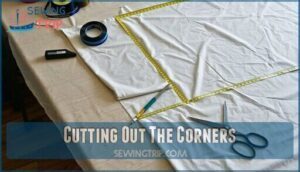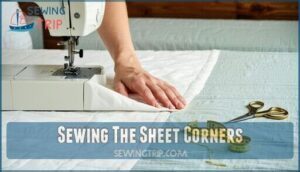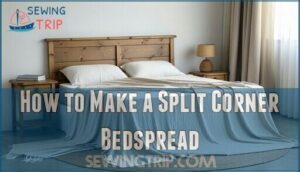This site is supported by our readers. We may earn a commission, at no cost to you, if you purchase through links.
 Learning how to sew a fitted bedspread transforms your bedroom into a custom sanctuary.
Learning how to sew a fitted bedspread transforms your bedroom into a custom sanctuary.
Start by measuring your mattress length, width, and depth, adding seam allowances. Cut your fabric panels, then create fitted corners by cutting squares from each corner equal to your mattress depth plus seam allowance.
Sew the corner seams to form a box shape, then hem the edges and add elastic around the perimeter for a snug fit.
The key is precise measurements and strong corner construction. While it might seem challenging at first, mastering this technique opens up endless possibilities for fabric choices and design variations that perfectly complement your space.
Table Of Contents
- Key Takeaways
- What is a Fitted Bedspread?
- Why Use a Fitted Bedspread?
- Types of Bedspreads
- How to Measure for a Fitted Bedspread
- How to Sew a Fitted Bedspread
- Tips for Sewing a Fitted Bedspread
- How to Make a Split Corner Bedspread
- How to Turn a Throw Type Bedspread Into a Fitted Spread
- How to Make a Split Corner Bed Skirt
- Variations and Creative Ideas for Fitted Bedspreads
- Frequently Asked Questions (FAQs)
- Conclusion
Key Takeaways
- Measure accurately – You’ll need precise mattress length, width, and depth measurements plus seam allowances to create a professional-looking fitted bedspread that won’t bunch or slip.
- Cut strategic corners – Remove corner squares equal to your mattress depth plus seam allowance, then sew these edges together to form the fitted box shape that hugs your mattress.
- Choose the right fabric – Medium-weight materials like cotton, linen, or twill hold their shape best and provide durability for daily use and washing.
- Secure with elastic – Attach elastic around the perimeter (about two-thirds of the bedspread’s edge length) using zigzag stitches to ensure your fitted bedspread stays put all night.
What is a Fitted Bedspread?
A fitted bedspread is a custom-tailored bed covering that hugs your mattress’s exact dimensions, eliminating bunching and tucking.
Custom-tailored bedding that hugs your mattress perfectly – no more bunching or slipping!
Unlike traditional bedspreads, it stays put throughout the night thanks to fitted corners or elastic attachments.
This bedding style offers superior mattress fit and creates a polished, hotel-like appearance.
With proper fabric selection and bedspread customization, you’ll enjoy effortless bed-making, and custom bedspread projects transform ordinary bedrooms into designer spaces, proving that DIY bedspread sewing delivers both bedspread benefits and personal satisfaction.
To achieve a perfect fit, consider using techniques for creating a fitted sheet alternative.
Why Use a Fitted Bedspread?
Anyone can master the art of creating a fitted bedspread with basic sewing skills.
These bedding solutions offer superior bedspread benefits compared to traditional throws. Your custom bedspread stays perfectly in place, eliminating daily tucking and wrinkled corners.
DIY bedspread projects let you control fabric choice, matching your home decor perfectly. Fitted bedspread sewing saves money while delivering professional results.
You’ll sleep better knowing your bedding won’t shift during the night, creating a polished look that lasts for years. Choosing the right best material options is essential for a comfortable and durable bedspread.
Types of Bedspreads
When you’re ready to sew a fitted bedspread, you’ll need to choose between two main types that work best for different bed styles.
The split corner bedspread works perfectly for beds with footboards or posts, while the throw type bedspread converts any flat bedspread into a snug-fitting cover.
Split Corner Bedspread
A split corner bedspread solves the classic bed-making puzzle when footboards and posts get in your way. This clever design features vertical slits at each bottom corner, allowing the fabric to drape neatly around obstacles without bunching or looking messy.
Split corners turn bed-making nightmares into effortless elegance.
Start with precise measurements. Measure your mattress length, width, and height to the floor, then add 1.5 inches for seam allowances. The split corner bedspread requires accurate corner placement to align with your bed’s posts or footboard design.
For construction, cut vertical slits at each bottom corner based on your measurements. Use proper seam finishing techniques to prevent fraying – double-hem the raw edges for durability. Corner stitching demands attention to detail, especially when creating the split openings.
Fabric selection matters for this fitted bedspread style. Choose medium-weight materials that hold their shape well. Cotton, linen, or twill work excellently for split corner bedspreads.
These sewing techniques create a customized, professional appearance while accommodating your bed’s unique features perfectly. Understanding the benefits of a split corner design can help you make informed decisions about your bedspread.
Throw Type Bedspread
Converting a regular throw bedspread into a fitted version saves money while creating a custom solution. This throw type bedspread transformation requires basic sewing techniques and proper bed measurements.
Start by measuring your mattress dimensions and adding seam allowances. Turn your throw inside out to hide raw edges, then create corner fittings by pinching and sewing fabric at each corner.
Here’s your roadmap:
- Measure mattress length, width, and depth accurately
- Add 2-inch seam allowance to all fabric choices
- Pin corners while bedspread remains inside out
- Sew elastic attachments at corner seams for security
This sewing technique creates fitted pockets that hug your mattress perfectly. The bedspread pattern emerges naturally as you work, transforming a flat throw into a custom cover.
How to Measure for a Fitted Bedspread
Proper mattress measurements transform your sewing project from guesswork into precision craftsmanship. You’ll need accurate bed size measurements to create a perfectly fitted bedspread that won’t slip or bunch.
- Measure mattress length – Head to foot, adding 16 inches for pillow tuck
- Calculate mattress width – Side to side at widest point
- Record depth measurement – Top surface to floor for proper drop
- Determine fabric width – At least 54 inches for all bed sizes
- Add seam allowance – Extra 1.5 inches on all sides for hemming
Corner measurements guarantee your bedspread fits snugly around mattress edges.
Record all bedspread measurements carefully to avoid costly fabric mistakes.
To achieve the best fit, consider the mattress depth guide for your sewing project.
How to Sew a Fitted Bedspread
Now you’re ready to turn your carefully cut fabric pieces into a professional-looking fitted bedspread.
With your measurements complete and fabric prepped, the sewing process involves six key steps that’ll transform your flat material into a custom-fitted cover.
Cutting Out The Corners
Once you’ve measured your fabric, it’s time to tackle corner cutting with precision.
Mark each corner square using your mattress depth measurement, then cut diagonally from corner to corner.
This creates the foundation for fitted corners that’ll hug your mattress perfectly.
Remember, accurate corner cutting determines how well your split corner bedspread will fit around the bed frame.
To achieve professional results, consider using specialized corner cutting tools for precise cuts.
Sewing The Sheet Corners
Now you’ll align the fabric edges with your footboard measurements, ensuring split corner precision.
Press the corner alignment carefully, then secure each fitted corner with strong stitches.
Use proper corner sewing techniques to prevent bunching—stretch the fabric taut while stitching.
Edge finishing comes next, so focus on seam security now.
These corner fitting fundamentals create professional-looking fitted corners that’ll stay put through countless washes.
Pressing The Edges
A good press is half the battle won. Grab your iron and focus on Edge Folding and Seam Pressing for a crisp, professional look.
Smooth the fabric as you go—think of it as giving your bedspread a spa day.
- Press seams flat for sharp lines and Wrinkle Removal
- Crease corners precisely for neat Corner Creasing
- Finish hems with careful fabric pressing
Sewing The Elastic to The Sheet
Now you’ll attach the elastic to create that snug, secure fit. Cut elastic to about two-thirds of your bedspread’s perimeter. Use a zigzag stitch to sew elastic while stretching it to match the fabric length, creating even gathers around the edges.
| Elastic Placement | Technique |
|---|---|
| Corner-only method | Sew 12-14 inch pieces at each corner seam |
| Full casing method | Thread elastic through entire hem opening |
| Stretch-and-sew method | Attach elastic directly while stretching to fit |
The elastic attachment transforms your flat bedspread into an elasticized sheet that hugs your mattress perfectly. Focus on maintaining consistent fabric tension as you sew – this prevents bunching and helps your fitted bedspread stay smooth. Your sewing skills will shine through proper elastic stretch control during this vital step. To achieve a professional finish, consider using high-quality elastic bed sheets materials for the best results.
Finishing Your Fitted Sheet
The final stretch brings your fitted sheet project to completion.
Turn the sheet right side out and inspect every seam for loose threads that need trimming. This careful seam finishing guarantees your handmade bedspread looks professionally crafted and withstands regular washing.
- Seam Finishing: Trim all loose threads using sharp fabric scissors for clean edges
- Edge Hemming: Check that all hems lie flat without puckering or bunching
- Corner Binding: Ensure elastic corners create smooth, rounded pockets without excess fabric
- Fabric Folding: Press final seams with an iron for crisp, professional appearance
- Thread Selection: Verify all stitching matches your chosen thread color throughout
Covering Your Mattress
How should you position your finished fitted bedspread on your mattress? Start by checking these essential steps:
- Mattress Protection: Place a quality mattress pad underneath for added comfort and longevity
- Bedding Options: Choose complementary sheets and pillowcases that coordinate with your custom bedspread fabric
- Fabric Choices: Verify your sewing techniques created proper stretch and fit for smooth application
- Bed Accessories: Add decorative pillows or throws to showcase your sewing skills and measurements precision
- Final Positioning: Tuck corners securely, making certain your fitted bedspread lies flat without bunching or shifting
Tips for Sewing a Fitted Bedspread
Creating a professional fitted bedspread requires attention to fabric choice, construction techniques, and bed-specific requirements.
These essential tips will help you achieve a polished result that fits securely and lasts for years.
Choosing The Right Fabric
Your fabric selection determines your bedspread’s longevity and performance.
Medium to heavyweight fabrics like cotton, linen, or twill hold their shape best and resist daily wear.
Cotton offers excellent washability factors and print longevity, while linen provides superior fabric durability despite initial stiffness.
Consider seasonal fabrics—lightweight cottons for summer, heavier wool blends for winter.
Texture options range from smooth percale to textured twill, each affecting both appearance and fabric care instructions.
The right bedspread fabric choice involves understanding key best fabric options to guarantee a durable and comfortable fit.
Strong Stitches and Seam Allowances
Your sewing machine’s settings make or break your fitted bedspread project. Set your stitch length to 2.5-3mm for strong stitches that won’t snap under tension. Choose thread that matches your fabric weight—polyester for synthetics, cotton for natural fibers.
Thread choice directly impacts durability and appearance. Maintain consistent fabric tension without pulling or bunching the material. Your sewing speed should stay moderate; rushing creates uneven stitches.
Use a generous 1/2-inch seam allowance on all edges—this extra fabric prevents fraying and provides strength for repeated washing. Double-stitch stress points where elastic meets fabric.
These sewing techniques guarantee your bedspread withstands years of use while maintaining its fitted shape and professional appearance.
Considerations for Different Bed Types
Different bed types require specific approaches for fitted bedspread success. Each bed frame style presents unique challenges that’ll test your sewing skills.
When working with platform beds, you’ll need to account for the solid base and lower profile. Platform Bed Tips include measuring from the mattress top to the floor since there’s no box spring. Your fitted bedspread should have minimal overhang to showcase the clean lines.
For bunk beds, accessibility becomes your biggest hurdle. Bunk Bed Solutions focus on:
- Easy application – You don’t want to wrestle with bedding in tight spaces
- Secure attachment – Kids move around, so your bedspread needs to stay put.
Standard beds with box springs require different mattress thickness calculations. Measure your mattress depth plus box spring height for accurate Custom Sizing. Split corner bedspreads work perfectly for beds with footboards or posts.
Different Bed Frame Styles demand specific fabric considerations. Heavy-duty king beds need reinforced stitching, while delicate canopy beds allow for decorative touches. Always measure twice before cutting your fabric – Mattress Fit depends on precision, not guesswork. To achieve a professional finish, consider using sewing bed sheets techniques for your project.
How to Make a Split Corner Bedspread
Why struggle with bedspread bunching around bed posts when you can create a perfectly customized split corner bedspread? This design features strategic slits at bottom corners, allowing fabric to drape smoothly around footboards and posts while maintaining a polished, hotel-like appearance.
Key elements for success:
- Corner Measurements: Measure from mattress top to floor, adding 1-2 inches for proper drape around posts
- Fabric Selection: Choose medium-weight cotton or linen that holds shape well and resists fraying
- Sewing Techniques: Use French seams on split edges to prevent unraveling and create professional-looking corners
Start by cutting vertical slits at each bottom corner, then hem raw edges with double-fold techniques. This bedspread custom approach guarantees your fitted bedspread accommodates any bed frame while elastic attachment isn’t needed since splits provide natural flexibility.
How to Turn a Throw Type Bedspread Into a Fitted Spread
Converting your throw bedspread into a fitted version requires strategic placement and precise sewing techniques. This bedspread conversion transforms loose fabric into a snug, custom cover that stays put all night.
Start by measuring your mattress dimensions and adding 12 inches to both length and width for proper overhang. Cut your throw bedspread to these measurements, including a 1-inch seam allowance on all sides.
Here’s your step-by-step throw conversion process:
- Mark corner squares – Cut out squares measuring your mattress depth plus 1 inch from each corner
- Pin edges together – Align the cut edges to form box corners
- Sew corner seams – Use a ½-inch seam allowance for durability
- Add elastic bands – Insert elastic strips at corners for a secure fit
- Hem raw edges – Finish all exposed edges to prevent fraying
Your bedspread styling now features clean lines and a professional appearance. These sewing techniques guarantee your fitted bedspread won’t shift during sleep, giving you the control and mastery you’ve been seeking over your bedding situation.
How to Make a Split Corner Bed Skirt
Now that you’ve perfected your fitted bedspread, a split corner bed skirt completes the polished look. This custom piece frames your bed beautifully while accommodating footboards and bed posts.
**Measure twice, cut once.
Accurately measure and mark the corners of the bed skirt before cutting any fabric.
**Mind the depth.
Calculate the drop or length from the bed frame to the floor. Adjust for box springs and bed height.
**Choose wisely.
Opt for medium to heavyweight fabrics with a nice drape. Polyester blends limit wrinkles.
Start by cutting three bed skirt panels – two for the sides and one for the foot. Leave the head section open for easy bed access. Use a 1/2-inch seam allowance when sewing panels together. Pin edges carefully before creating straight seams.
Different bed skirt styles require varying skirt drops, so measure your specific setup.
Quality sewing techniques matter here. Use strong thread and double-stitch corner fittings for durability. Hem raw edges to prevent fraying.
Your fabric choices directly impact the final appearance – select materials that complement your room’s aesthetic.
- Picture crisp, custom lines that transform your bedroom into a magazine-worthy space with professional-looking corner fittings.
Variations and Creative Ideas for Fitted Bedspreads
Beyond basic fitted bedspread construction, you can discover creative possibilities through decorative elements.
Consider incorporating custom trims like scalloped edges or welt cording along seams for polished definition.
Fabric embellishments such as embroidery, appliqué, or contrast piping transform simple designs into statement pieces.
Mix bedspread patterns boldly—geometric prints paired with solid color schemes create visual interest.
Your sewing projects become uniquely yours when you experiment with reversible fabrics, allowing seasonal style changes.
These creative ideas elevate your fitted bedspread from functional to fabulous.
Frequently Asked Questions (FAQs)
What do you call a bedspread with fitted corners?
Fitted bedspreads feature fantastic functionality – they’re called "fitted" or "hugger" bedspreads. You’ll find elastic corners secure snugly around your mattress, preventing annoying shifting while you sleep peacefully.
How to sew a fitted sheet for beginners?
Measure your mattress length, width, and depth.
Cut fabric with 5-inch seam allowances.
Sew corners with elastic bands to create fitted pockets.
Hem edges and press seams flat for a professional finish.
How to make a king size bedspread?
King-size bedspreads require fabric at least 108 inches wide.
You’ll need approximately 8-10 yards of fabric.
Start by measuring your mattress dimensions, adding 16 inches for length and calculating drop measurements for proper fit.
Can you wash a fitted bedspread in machine?
Picture steam rising from your washing machine as you tackle that cozy bedspread question.
Yes, you can absolutely machine wash most fitted bedspreads.
Check the care label first, use gentle cycle with cold water, and avoid overloading your machine for best results.
How do you store fitted bedspreads properly?
Store fitted bedspreads folded flat in breathable cotton bags or linen closets.
Avoid plastic storage that traps moisture.
Clean before storing, and refold periodically to prevent permanent creases from setting in, this helps in preventing permanent damage.
What thread type works best for durability?
You’ll want polyester thread for strength, or cotton-wrapped polyester for the best of both worlds.
Coincidentally, many sewers discover polyester’s superiority only after cotton thread breaks during their most important projects, teaching them this valuable lesson the hard way.
How do you fix torn elastic corners?
Remove the torn elastic by carefully cutting stitches.
Cut new elastic measuring mattress width plus two inches.
Pin elastic to corner seams, stretching taut while sewing with strong zigzag stitches for secure attachment.
Can you make fitted bedspreads for adjustable beds?
Yes, you can make fitted bedspreads for adjustable beds, but you’ll need to account for the bed’s movement and flexibility.
Use stretchy fabrics like jersey knits or add extra elastic at stress points to accommodate the bed’s adjustments without tearing, ensuring the bedspread remains intact during adjustments.
Conclusion
Creating this timeless bedroom essential brings together careful measurement, patient construction, and thoughtful finishing touches.
You’ve mastered how to sew a fitted bedspread that transforms any ordinary mattress into a professionally styled centerpiece.
The elastic perimeter guarantees your creation stays perfectly positioned through countless nights of sleep.
Your new skills reveal endless decorating possibilities, allowing you to coordinate fabrics with seasonal changes or room updates.
This practical project combines function with beauty, proving that handmade doesn’t mean homemade-looking.
- http://mailto:jglasser.com.
- https://en.wikipedia.org/wiki/Bedding
- https://brandream.us/blogs/news/what-is-split-corner-bed-skirt
- https://www.target.com/p/gracie-mills-sandy-3-piece-split-corner-classic-pleated-quilted-bedspread-set-king-white/-/A-1001225168
- https://simplyfrenchmarket.com/products/high-ruffle-skirt-bedspread



















